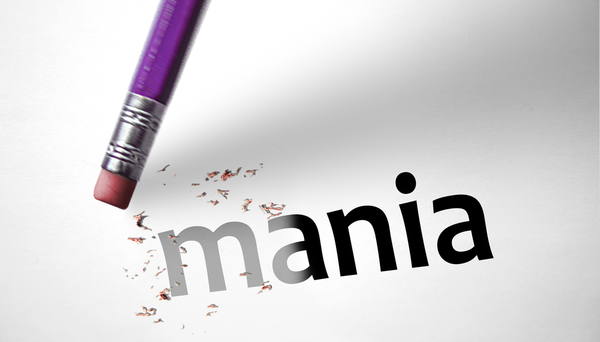Mania is a psychological and behavioral state where a person experiences abnormally elevated energy levels. Mania, or manic episode, is usually talked about in the context of bipolar disorder, but it can also occur in other mental health conditions and independently.
A toned-down version of mania, hypomania, can occur with or without bipolar disorder.
Bipolar disorder is when a person experiences alternating episodes of elevated energy (mania) and lowered energy (depression).
The abnormally elevated energy levels in mania result in symptoms like:
- Experiencing intense, euphoric mood or irritability that is unexpected and out of character for the person
- Being hyperactive and doing multiple things at a time
- Having racing thoughts and speech
- Decreased need for sleep
- Impulsive and reckless behavior
- Feelings of grandiosity and invincibility
Signs a manic episode is ending
A manic episode can last for months1, but it does eventually subside. Following are the signs that a manic episode is ending or has ended:
1. Decreased energy
The most significant sign that a manic episode is beginning to end is that the person’s energy levels decrease. Mania makes a person feel a sense of urgency which leads to hyperactivity.
Feeling tired after an episode of mania is common because mania causes a person to expend significant amounts of energy.
2. Normalized thought and speech patterns
Racing thoughts and speech characterize mania. The manic person jumps from one topic to another, and keeping up with them is hard.
When mania subsides, thoughts and speech become slower and regular. The person becomes less talkative.
3. Reduced impulsivity
Mania makes a person indulge in reckless and risky behaviors because of increased impulsivity.
When the manic episode ends, the person exercises better judgment and self-control.
4. Overwhelm
During a manic episode, a person may take up multiple, unviable projects unthinkingly. When mania subsides, they realize how much they’ve overwhelmed themselves.
5. Normalized sleep and diet patterns
During mania, thanks to racing thoughts and hyperactivity, a person does not feel the need to sleep much. This lack of sleep is often accompanied by increased appetite, especially for pleasurable foods.
When the mania ends, normal sleep and diet patterns resume.
6. Decreased grandiosity and invincibility
During mania, a person experiences an uncharacteristic surge in self-esteem. They feel invincible and believe they can do anything—part of the reason why they take up multiple, grand projects.
When mania subsides, the person doesn’t feel so grandiose and invincible. Some manics may even view their grandiosity as ridiculous when the mania subsides.
7. Improved concentration
During a manic episode, a person is highly distractible, and their attention is all over the place. When the mania ends, they find they can focus better.
8. Re-established social awareness
Irritability and impulsivity during a manic episode may cause a person to behave in ways that are harmful to others. This decreased social awareness gets reversed when the mania ends, and the person can show concern for others.2
9. Re-established self-awareness
Impulsivity and loss of control during a manic episode can make a person feel like they’re not being themselves. Self-awareness and self-identity are re-established when a manic episode ends. The person has a clearer sense of who they are.
10. Re-established sense of reality
In some cases of mania, a person may experience delusions and hallucinations. When mania subsides, they get a better grip on reality.
References
- Tondo, L., H Vazquez, G., & J Baldessarini, R. (2017). Depression and mania in bipolar disorder. Current neuropharmacology, 15(3), 353-358.
- Carlson, G. A., & Goodwin, F. K. (1973). The stages of mania: A longitudinal analysis of the manic episode. Archives of general psychiatry, 28(2), 221-228.

